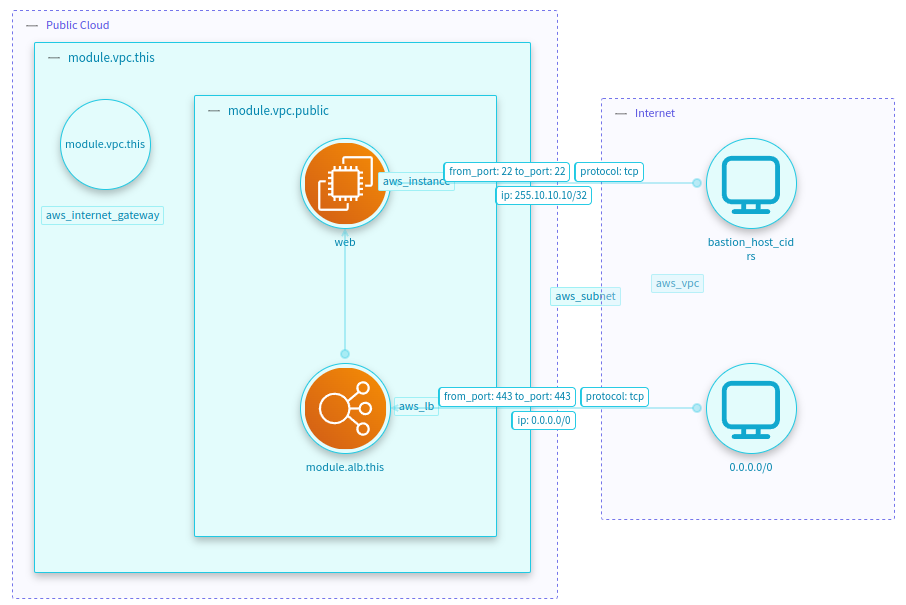Terraform Plan Attack Surface
Attack Surface is the set of all the possible ways an attacker can enter or extract data from a system.
Terraform Plan Processor represents the attack surface as the set of all the resources that can be accessed
by an attacker through the Internet.
How it works?
Firstly, we need to configure the mapping file to define the attack surface behavior. You will find all the parameters
required to enable this feature in the
Attack Surface Mapping Configuration.
After enabling it, the processor will generate the AttackSurface retrieving all the ingress data
from the Security Group Resources and their rules.
Example
Given the following Terraform files:
module "vpc" {
source = "terraform-aws-modules/vpc/aws"
version = "~> 5.0"
name = "VPC"
cidr = "10.0.0.0/16"
azs = ["eu-west-1a"]
public_subnets = ["10.0.10.0/24", "10.0.11.0/24"]
}
module "alb" {
source = "terraform-aws-modules/alb/aws"
version = "8.1.0"
name = "alb"
load_balancer_type = "application"
vpc_id = module.vpc.vpc_id
subnets = module.vpc.public_subnets
security_groups = [aws_security_group.alb.id]
enable_deletion_protection = false
idle_timeout = 900
}
resource "aws_instance" "web" {
ami = "ami"
instance_type = "t2.micro"
count = "${length(module.vpc.public_subnets)}"
subnet_id = "${element(module.vpc.public_subnets, count.index)}"
launch_template {
id = aws_launch_template.web.id
version = "$Latest"
}
}
resource "aws_launch_template" "web" {
name_prefix = "tl-prefix"
instance_type = "t2.micro"
key_name = "alt_web"
network_interfaces {
description = "primary interface"
associate_public_ip_address = true
delete_on_termination = true
device_index = 0
security_groups = [aws_security_group.web.id]
}
}
resource "aws_security_group" "alb" {
name = "ALB SG"
description = "Allow access traffic to ALB"
vpc_id = module.vpc.vpc_id
}
resource "aws_security_group_rule" "https-ingress" {
security_group_id = aws_security_group.alb.id
description = "HTTPS access from the world"
type = "ingress"
from_port = 443
to_port = 443
protocol = "tcp"
cidr_blocks = ["0.0.0.0/0"]
}
resource "aws_security_group" "web" {
name = "Web SG"
description = "Allow access HTTP and SSH traffic to aws instance"
vpc_id = module.vpc.vpc_id
ingress {
description = "SSH access from bastion host"
from_port = 22
to_port = 22
protocol = "tcp"
cidr_blocks = [var.bastion_host_cidrs]
}
ingress {
description = "HTTP access from ALB"
from_port = 8080
to_port = 8080
protocol = "tcp"
security_groups = [aws_security_group.alb.id]
}
}
The Terraform Plan Processor will generate the following Attack Surface:
otmVersion: 0.1.0
project:
name: Attack Surface
id: attack-surface
representations:
- name: Terraform
id: Terraform
type: code
trustZones:
- id: b61d6911-338d-46a8-9f39-8dcd24abfe91
name: Public Cloud
risk:
trustRating: 10
- id: f0ba7722-39b6-4c81-8290-a30a248bb8d9
name: Internet
risk:
trustRating: 1
components:
- id: aws_instance.web
name: web
type: ec2
parent:
component: module.vpc.aws_subnet.public
tags:
- aws_instance
- id: module.alb.aws_lb.this
name: module.alb.this
type: load-balancer
parent:
component: module.vpc.aws_subnet.public
tags:
- aws_lb
- id: module.vpc.aws_internet_gateway.this
name: module.vpc.this
type: empty-component
parent:
component: module.vpc.aws_vpc.this
tags:
- aws_internet_gateway
- id: module.vpc.aws_subnet.public
name: module.vpc.public
type: empty-component
parent:
component: module.vpc.aws_vpc.this
tags:
- aws_subnet
- id: module.vpc.aws_vpc.this
name: module.vpc.this
type: vpc
parent:
trustZone: b61d6911-338d-46a8-9f39-8dcd24abfe91
tags:
- aws_vpc
- id: b0a3f48b-e876-4903-9931-31a1c7e29c17
name: 0.0.0.0/0
type: generic-client
parent:
trustZone: f0ba7722-39b6-4c81-8290-a30a248bb8d9
- id: 0810be7c-0673-478c-95d4-44803b835917
name: bastion_host_cidrs
type: generic-client
parent:
trustZone: f0ba7722-39b6-4c81-8290-a30a248bb8d9
dataflows:
- id: 81dc59db-dbd4-41a5-bc5f-42e56e655f32
name: module.alb.this to web
source: module.alb.aws_lb.this
destination: aws_instance.web
bidirectional: false
- id: 31292a10-47b0-4e2d-b172-c150eeca66a8
name: HTTPS access from the world
source: b0a3f48b-e876-4903-9931-31a1c7e29c17
destination: module.alb.aws_lb.this
bidirectional: false
tags:
- "protocol: tcp"
- "from_port: 443 to_port: 443"
- "ip: 0.0.0.0/0"
- id: 9cdc7ad0-253f-44d3-9f7c-548fb19a42fc
name: SSH access from bastion host
source: 0810be7c-0673-478c-95d4-44803b835917
destination: aws_instance.web
bidirectional: false
tags:
- "protocol: tcp"
- "from_port: 22 to_port: 22"
- "ip: 255.10.10.10/32"
